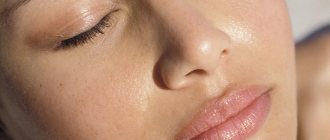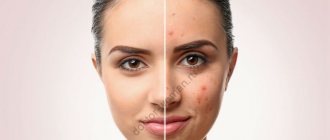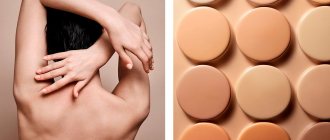Features of dry facial skin
Dry skin is often confused with dehydrated skin. However, these concepts have fundamental differences. Dehydrated skin looks loose and is characterized by deep and long wrinkles. She suffers from a lack of moisture due to changes in the intercellular matrix of the dermis. But this problem can occur with both normal and oily skin.
Dry skin has impaired barrier properties, so it lacks not only moisture, but also fatty lubrication. In addition, dehydration can be eliminated, while skin type is determined at the genetic level.
Although in both cases the skin feels a lack of water, the methods of moisturizing will be radically different. This is due to the level of external influences and structural changes that led to the shortage.
Treatment
You can often hear that if you are faced with a similar problem, the most important thing is to achieve proper, deep and constant hydration. However, this is not the only recipe for getting rid of difficulties. In general terms, the line of behavior is correct, but often it is necessary to get rid of the factor that provokes the deterioration of the situation, and this is why tests are prescribed and examinations are carried out.
After diagnosis, the doctor will draw up a list of measures on what to do if your body skin is very dry. As a rule, it begins with drawing up a balanced diet and establishing a drinking regime. You should also try to avoid the influence of negative environmental phenomena: do not wash your face with hard water, avoid exposure to direct sunlight, and do not be in the wind.
It is important to remember that lifestyle changes, including quitting smoking, also have a beneficial effect on the condition of the epidermis.
If dryness is associated with disruption of any organs and systems, including endocrine and digestive, treatment is carried out by a specialized specialist in contact with a dermatologist.
Signs of dry facial skin
One of the main indicators of dry skin is the absence of oily shine. Try going without makeup or skincare products for a few hours, and then pat your skin dry with a tissue. If there is no oily shine, most likely you have a dry type. There are other signs that point to it:
- feeling of tightness,
- high sensitivity,
- severe dryness in winter,
- invisible pores
- no rashes, pimples,
- frequent peeling
- early signs of aging (wrinkles).
Constant peeling
If you experience persistent discomfort, it is necessary to undergo a diagnosis because:
- it can be a consequence of various diseases, including endocrine ones;
- stable peeling occurs in places that are subject to regular mechanical stress (for example, knees and elbows);
- persistent dryness may be the result of an allergy that is not seasonal.
So the question of why the skin on the body dries so much and what to do if the epidermis continues to deteriorate should lead you to a dermatologist’s office, who will prescribe a comprehensive examination.
Causes of dry facial skin
Dry skin is characterized by tightness, flaking, dull tone, regular irritation and a finely porous structure. These features are genetic and associated with insufficient production of sebum and low activity of the sebaceous glands.
This is why dry skin has a very thin hydrolipid barrier. It consists of water, fatty acids and in normal condition protects the skin from negative factors. But in the dry type, this barrier functions poorly, which leads to negative consequences: disruption of the lipid and water barrier, weak functioning of the sweat and sebaceous glands, and a slightly acidic pH reaction (acid-base state).
Despite the fact that your skin type is given at birth, you can choose the right skin care products and get rid of the negative features inherent in dry skin.
How to care for dry skin
Rules for caring for dry skin involve internal and external effects on the body. You should add to your diet dishes with vitamin E (radish, nuts, corn), A (fish oil, broccoli, tomatoes), and group B: fish, dairy products, bread.
It is also important to take care of the outside of your skin. Use special products regularly: they have a cumulative effect, so interrupting care is not recommended.
- Always cleanse your skin of makeup.
- Use skin care creams not only for your face, but also for your hands and feet.
- You need to moisturize your skin twice a day: in the morning (at least half an hour before going outside) and in the evening, an hour before bedtime.
- During sleep, skin cells are restored, and due to lack of sleep, the barrier function deteriorates, hydration decreases, and tone changes. So don't neglect your sleep.
Features of seasonal skin care
Daily care for dry skin is the main guarantee of freshness and tone at any time of the year. However, specific care is largely related to humidity, temperature and other weather conditions.
in winter
During this period, the most dramatic temperature changes begin: it is cold and windy outside, and the air at home is hot and dry. Therefore, the skin dries out even more and needs intensive care. Apply the cream daily, and at least half an hour before leaving the house, use skincare products so that they are better absorbed.
in spring
In the first half of spring, frost and wind persist, and therefore intensive protection is still important. Products with a lighter texture are suitable. It’s also worth buying a cream or lip balm: they need care all year round, but in the spring they become chapped especially badly.
In summer
In summer, ultraviolet radiation has a particularly strong effect on the skin. Use skincare products for regeneration (for example, with aloe vera extract) and moisturizing: it is best to apply it in the evening.
in autumn
After a hot summer, skin care is especially important: it suffers from increased dryness. We need to prepare her for the coming cold weather. At this time, nourishing and moisturizing products are suitable.
How to keep your skin beautiful and healthy in winter
In our health section, we have already talked about how the skin is a kind of “mirror of the health” of our body. And in order for it to conscientiously perform its many functions, it is necessary to pay special attention to it. Dermatologists from City Clinical Hospital No. 52 talk about the features of skin care in winter
And
.
What problems await our skin in winter? Firstly, the air in the room is dry from heating appliances. Secondly, frost and cold wind outside. Thirdly, a sharp change in temperature when you leave the house to go outside. Not only exposed parts of the body suffer, but also those protected by clothing. Therefore, we will focus on all possible areas of the skin that require close attention in the winter season, and will start with the facial skin that is most exposed to environmental factors.
Face
If we at least somehow protect and shelter all other parts of the body from frost and wind, then the face takes all the blows of winter weather. Under the influence of low temperatures and wind, the skin becomes dry, more sensitive, and wrinkles easily form on it. Low temperatures constrict blood vessels, and the skin of the face lacks nutrients brought by the blood.
Thus, winter facial care should include additional moisturizing and nourishing of the skin, as well as protection from frost and wind.
Moisturizing
After washing and cleansing your face, be sure to use a tonic or lotion - it forms a film that retains moisture in the skin.
In windy winter weather and when playing sports outdoors, you should not use moisturizer. In winter, it is recommended to apply this cream to the face at night, and in the morning, before going outside, use a nourishing one, it will protect against frost. If you use two types of cream of the same brand - moisturizing and night, simply swap them. By the way, in winter, foundation made with a fatty base protects well from the cold.
If you usually used moisturizers for oily skin, then in winter switch to products for normal skin.
If your skin is normal, use moisturizers for dry skin. If your skin is dry, use your usual moisturizer, but 1.5 - 2 times more often than at other times of the year. Nutrition
The nourishing cream applied in the morning should be thick and greasy, and even in our middle zone it should have protection from UV radiation - with a minimum factor of 15 SPF. The cream is applied ten minutes before applying foundation. If you're going on a ski holiday, your morning cream should have a protection rating of at least 30, and preferably 50. The same goes for your lipstick.
Pay attention to products from Russian manufacturers. Facial care products from the factories “Svoboda”, “Nevskaya Kosmetika”, “Black Pearl” take into account the specifics of the climate of the middle zone, which is significantly different from the European one. Also consider cosmetics produced in northern European countries (Finland, Sweden), which take into account the climatic conditions, including our country, and combine components that provide protection and nutrition. Pay attention to the content of 100% natural oils, herbal extracts, vitamins A and E in face cream, including eyelid cream, which are the main active substances: nourish and soften the skin, activate metabolic processes in it, increase elasticity and elasticity. Creams containing emollient components (squalane, rep and avocado phytosterols, macadamia oil, argan, jojoba), oligoelements (zinc and silicon), and essential fatty acids (linoleic and linolenic) will be useful.
LIPS
All the same rules apply to protecting lips in winter. Frost and wind, and especially the habit of breathing through the mouth in the cold, cause peeling of the lips. Therefore, at this time of year, you should always have hygienic lipstick or a special moisturizing balm on your lips. Pay attention to the composition of your winter lipstick: it should be based on beeswax and fat and contain a sun protection factor of at least 20.
If your lips are flaky, use a special lip scrub. At home, it is useful to lubricate your lips with honey or cucumber juice. Vegetable oils - castor, olive, applied for 10 minutes daily are wonderful nourishment for the lips. If desired, you can add a couple of drops of lemon to the oil.
BODY
In winter, no matter how strange it may seem, you should not take a hot shower - only a warm one. Hot water increases heat and water transfer, and the skin dries faster. a long stay in hot water will completely deprive the skin of its protective fat layer, leading to an increase in its dryness. You shouldn’t completely deny yourself the pleasure of soaking in the bath, but you need to remember the duration of the pleasure - no more than 15 minutes, and the water temperature should not exceed 40°C. In winter, do not use regular soap, prefer moisturizing cream soap or shower gel containing cream. Once a week, you can use a body scrub instead of shower gel or before it to remove dead cells from the surface layer of skin. After a shower, use body milk, applying it evenly over the entire surface with massaging movements.
HANDS
The skin of your hands is very delicate; it instantly reacts to lack of care, becoming dry, tight and cracked. The “winter” rule is that you should always wear mittens or gloves outside. You should stop using antibacterial hand cleansers - they lead to dry skin. Try to wash dishes and clean the house only with gloves.
Thick creams are suitable for hand skin care. At night, it’s good to make special masks: apply a thick layer of cream to your hands, put on cotton gloves and do nothing for at least 2 hours (you can go to bed).
LEGS
In winter, you need to take care of your feet even more carefully than in summer. Due to constant contact with woolen fabrics and dense synthetics (socks and tights), insufficient air exchange due to wearing closed shoes, the skin of the feet becomes drier than usual. Hyperkeratosis occurs - thickening of the upper layer of the epidermis and, unfortunately, a regular pedicure does not help in such cases. It is necessary to use daily creams and other cosmetics that contain keratolytics - active substances that soften and remove dead skin (they contain salicylic and lactic acid, urea), as well as foot scrubs (they contain coarser exfoliating components than scrubs for body).
To soften rough skin on the feet, oil wraps help: warm oil (olive, peach or coconut) is applied to the feet, and woolen socks are put on the feet. After 30 minutes, the oil is washed off with warm water. At night you need to use a nourishing foot cream, thicker than in the summer. Before going to bed, it is also advisable to do a foot massage - it relieves fatigue and stimulates metabolic processes in the body. In the morning after a shower, before putting on tights and socks, it is useful to use quickly absorbing moisturizers with a deodorizing effect - to prevent dryness and eliminate unpleasant odors during the day. And take it as a mandatory rule: to allow your feet to “breathe”, change your shoes indoors, change your winter shoes to lighter replacement ones.
HUMIDIFYING FROM THE INSIDE
You also need to take care of moisturizing the skin from the inside, for which you should drink more fluid. It can be plain water, juice, compote. Tea and coffee, on the contrary, promote faster removal of moisture from the body - they should not be abused. The average amount of liquid taken per day in winter should be at least 2 liters.
INDOOR MICROCLIMATE
Winter skin care is not only masks, tonics and creams. This also means maintaining adequate temperature and humidity conditions in the apartment and at work.
To reduce the degree of dehydration and drying of the skin (and this is due to central heating radiators and air conditioning), it is necessary, if possible, to maintain the room temperature at 18-20 ° C and be sure to use air humidifiers (steam humidifiers or ultrasonic water sprayers), especially at night. If it is not possible to use special devices, you can simply pour water into wide containers and place them on window sills or cabinets - the water, evaporating at room temperature, will create an optimal level of humidity.
IF YOU HAVE PROBLEMS
If alarming symptoms occur on the skin or during an exacerbation of chronic skin diseases at any time of the year, dermatologists from City Clinical Hospital No. 52 will come to your aid. You can make an appointment by phone or through the Make an appointment form.
Mistakes in caring for dry skin
Not everyone understands how to care for dry skin. Of course, dryness is aggravated due to sea and chlorinated water, natural factors such as wind, cold, dry air, exposure to ultraviolet radiation, as well as a deficiency of vitamins A, B, E. But some reasons are related to a person’s lifestyle. Check if you are making any mistakes:
- often go to the solarium or to the beach,
- have bad habits: alcohol, smoking, caffeine addiction,
- wash your face with hot water or take an excessively hot bath,
- do strong peelings or use cleansing masks,
- use alcohol lotions and alkaline soaps,
- limit yourself in every possible way in your diet,
- You don't moisturize your skin at all.
Proper care and a healthy lifestyle will relieve your skin of tightness, flaking and discomfort. But incorrect care for very dry skin will only worsen its condition.
Dry sensitive cracking skin: causes
Dry skin can be caused by a variety of factors:
- deficiency of vitamins A, B, E;
- disruptions in the functioning of the endocrine system;
- negative climatic and atmospheric influences;
- improper diet and imbalance of water balance in the body;
- chronic sleep disorders, etc.
The skin also often becomes dry due to age-related hormonal changes. Signs of dry aging skin:
- loss of elasticity and sagging – primarily in the cheeks, neck and chin;
- grayish tint;
- the appearance of pigmentation;
- the appearance of wrinkles.
Irritated skin, when it dries out, also often flakes and causes itching. What to do in such a situation? Pay special attention to facial care - independently and with the help of professionals.
How to choose dry skin care products
Proper care for dry skin is largely due to the lack of necessary care products.
- Look for the inscription “For dry skin”: these products contain the most useful substances.
- Avoid products with alcohol, alkalis, aggressive surfactants, and mineral oils: they make the skin drier and cause a feeling of tightness.
- Also, do not use products with clay: it draws out moisture.
- Use products that contain antioxidants, ceramides, glycerin, and natural oils - they moisturize the skin well.
Ceramides must be included in skincare products for dry skin. They are the key elements of the stratum corneum. These natural lipids, along with fatty acids, form the lipid layer of the skin. They, like cement, connect the cells of the epidermis and hold water molecules, thereby maintaining the moisture of the stratum corneum.
Thanks to their properties, ceramides fight damage to the cell structure. This applies to defects caused by external factors and skin diseases: psoriasis, atopic dermatitis. In this case, you should use different skincare cosmetics for different parts of the body - face, lips, hands and feet.
- The thin skin on the lips reacts most quickly to environmental influences. So lips need special attention and careful care. Ultra-hydrating Cera Lip Balm with Vitamin E nourishes delicate skin, protecting it in any weather. It prevents the appearance of cracks, promotes regeneration and is suitable as a base for lip makeup - so you can use the balm at any time of the day.
- Lack of moisture causes dryness, discomfort, and loss of elasticity of the facial skin. Therefore, it is important to provide her with water. Ultra-moisturizing Cera Cream for face and body restores the protective layer, soothes the skin and serves as an excellent base for makeup.
- The skin of the hands is exposed to the highest stress. It is affected by water quality, sunlight, and mechanical work. Ultra-moisturizing hand cream with ceramides is suitable for sensitive, very dry and irritation-prone skin. It reduces the feeling of discomfort, is quickly absorbed and does not leave a sticky film.
- The skin of the feet has the least amount of sebaceous glands, which is why it is most susceptible to dryness. Due to constant stress, the skin of the feet becomes rough and the heels crack. Ultra-moisturizing cera cream eliminates cracks and corns, moisturizes and softens rough skin.
Review of products for dry skin from La Roche-Posay
Micellar gel for face and eyelids Rosaliac Gel
ROSALIAC GEL
Micellar gel
Provides instant hydration, effectively removes makeup and gently cleanses sensitive skin.
RUB 1,935 more details
Moisturizing emulsion for skin prone to redness Rosaliac UV Legere
ROSALIAC UV LEGERE
Moisturizing emulsion
Moisturizes and softens the skin, strengthens the walls of blood vessels and soothes reactive skin of normal and combination types.
RUB 1,846 more details
Intensive moisturizer for dehydrated skin Hydraphase Intense Riche
HYDRAPHASE INTENSE RICHE
Moisturizer
The formula based on hyaluronic acid and glycerin of plant origin, vitamin E and shea butter intensely moisturizes, instantly eliminates the feeling of tightness and discomfort, and smoothes out dehydration creases.
RUB 1,933 more details
Intensive soothing care Toleriane Ultra
TOLERIANE ULTRA
Night cream-gel
Relieves tightness and itching, soothing even hypersensitive skin while you sleep.
RUB 1,784 more details
Toleriane Ultra Nuit restorative and soothing night care for the eye area
TOLERIANE ULTRA NUIT
Night soothing care
Intensively moisturizes and soothes the skin, reduces skin sensitivity, restores comfort and tone.
RUB 1,945 more details











